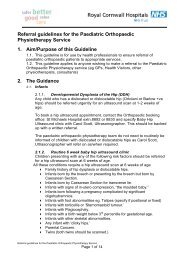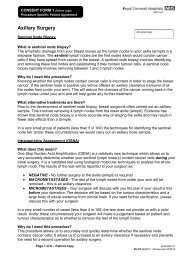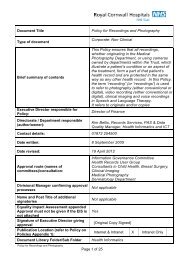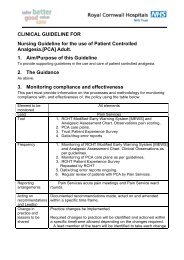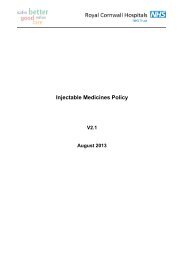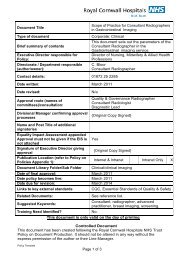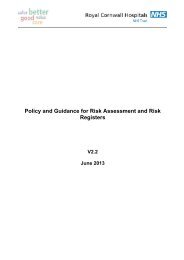Catheterisation in Adults - the Royal Cornwall Hospitals Trust ...
Catheterisation in Adults - the Royal Cornwall Hospitals Trust ...
Catheterisation in Adults - the Royal Cornwall Hospitals Trust ...
You also want an ePaper? Increase the reach of your titles
YUMPU automatically turns print PDFs into web optimized ePapers that Google loves.
sal<strong>in</strong>e is su itable. Observations should be recorded rout<strong>in</strong>ely 6<strong>in</strong>dicated.monthly or as cl<strong>in</strong>ically4.11 Chang<strong>in</strong>g <strong>the</strong> Ca<strong>the</strong>terThe pr<strong>in</strong>ciples of asepsis should apply to th e procedure of ur<strong>in</strong>ary ca<strong>the</strong>terisation, bothurethral and suprapubic (Appendix 3).For reca<strong>the</strong>terisation procedures, <strong>the</strong> exist<strong>in</strong>g ca<strong>the</strong>ter should be re moved, exam<strong>in</strong>ed forencrustations and disca rded at <strong>the</strong> start of <strong>the</strong> procedure. Extreme care should be takenwith supra-pubic ca<strong>the</strong> ters changes for those patients who are receiv<strong>in</strong>g anticoagulant<strong>the</strong>rapy or who have blood clott<strong>in</strong>g disorders.The first ch ange for both routes of entry <strong>in</strong>to <strong>the</strong> bladder can be don e <strong>in</strong> <strong>the</strong> co mmunity,ei<strong>the</strong>r <strong>in</strong> <strong>the</strong> patient’s home, community cl<strong>in</strong>ic or hospital by a competent HCP. Unless <strong>the</strong>reis a need for reca<strong>the</strong>terisation <strong>in</strong> a controlled environment, <strong>the</strong>re is no rationale fo r it to beonly done <strong>in</strong> a hospital sett<strong>in</strong>g. Urethral and supra-pubic lo ng-term ca<strong>the</strong>ters can be left <strong>in</strong>place for up to 12 w eeks, but reca<strong>the</strong>terisations may need to be carried ou t soonerdepend<strong>in</strong>g on <strong>in</strong>dividual needs. Some patients and <strong>in</strong>f ormal carers can be taug ht how tochange <strong>the</strong>ir own urethral or supra-pubic ca<strong>the</strong>ter.Conversion to suprap ubic ca<strong>the</strong>terisation from urethral ca<strong>the</strong>terisation is no t alwayssuccessful for female patients, as <strong>the</strong>re is a considerable risk of co<strong>in</strong>cidental urethralleakage, and patients should be warned of this risk.4.12 Patient EducationPatients (and carers) need to be <strong>in</strong>volved <strong>in</strong> <strong>the</strong>ir care, which <strong>in</strong>cludes b e<strong>in</strong>g aware of <strong>the</strong>complications of cath eterisation and correct <strong>in</strong>formation on general ca<strong>the</strong>ter car e. It isimportant that patients (and carers) know how t o identify a potential problem (Appendix 4)and whom to contact f or help. A programme of learn<strong>in</strong>g should <strong>in</strong>clude appr opriateliterature, i.e. leaflets; Ca<strong>the</strong>ter Passport. It is r ecommended that HCPs document that thishas been done.Advice on c are options regard<strong>in</strong>g sexual activity and ca<strong>the</strong> ters should be offered. Theseoptions may <strong>in</strong>clude teach<strong>in</strong>g <strong>the</strong> patient how to remove and re<strong>in</strong>sert <strong>the</strong> ca<strong>the</strong>ter before andafter <strong>in</strong>tercourse.4.13 Ur<strong>in</strong>e Sampl<strong>in</strong>gRout<strong>in</strong>e collection of ur<strong>in</strong>e specimens for cultur e is not useful and is unnecessary unless <strong>the</strong>patient is symptomatic (Nicolle 200 1). When a specimen collection is justified, a cl<strong>in</strong>icallyclean technique should be used, with dis<strong>in</strong>fection of <strong>the</strong> needle-free sample port with alcohol70% and chlorhexid<strong>in</strong>e 2% and allowed to dry t horoughly (Cl<strong>in</strong>ical Microbiology March 2012(BSOP 41)). It is important to <strong>in</strong>clude systemic symptoms on <strong>the</strong> cl<strong>in</strong>ical microbiology form.4.14 Care of <strong>the</strong> Suprapubic SiteIf dress<strong>in</strong>gs are cl<strong>in</strong>ically required, t hey must be sterile an d applied us<strong>in</strong>g an ase ptic nontouchtechnique. In most ca ses, a dress<strong>in</strong>g will not be required and patients sh ould beencouraged to clean <strong>the</strong> site daily.4.15 TraumaCa<strong>the</strong>ter tub<strong>in</strong>g and <strong>the</strong> dra<strong>in</strong>age bag should be secured to <strong>the</strong> leg so that it avoids k<strong>in</strong>ks <strong>in</strong><strong>the</strong> tub<strong>in</strong>g, t raction on t he bladder neck, trauma to <strong>the</strong> urethra, occlu sion of <strong>the</strong> ca<strong>the</strong>ter8 of 16




